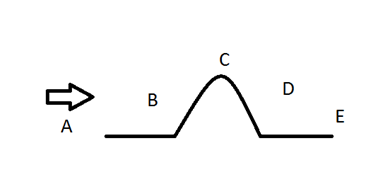
The following diagram shows a mountain with a sea breeze blowing as indicated by the arrow. Circle the letter for the area with air that would be both relatively warm and dry.

A. Area A
B. Area C
C. Area D
D. Area E

Answer
368.7k+ views
Hint: Land breezes return from land whereas ocean breezes return from the ocean or alternative giant bodies of water. The key distinction is thanks to the property of water to retain heat and heat up longer as compared to land. Land breezes also are referred to as off-shore winds whereas ocean breezes also are known as on-shore winds.
Complete step by step solution:
Land and ocean breezes develop owing to differential heating and cooling of adjacent land and water surfaces. Water includes a bigger heat capability than land, i.e. land absorbs and emits radiation a lot more expeditiously and quicker.
The bigger the temperature variations between land and ocean, the stronger the land breezes and ocean breezes. when sunset, the atmosphere on top of the coastal land quickly loses heat whereas the air
Land and ocean breezes are wind and weather phenomena related to coastal areas. A land breeze could be a breeze processing from land out toward a body of water.
A breeze could be a wind processing from the water onto the land. Land breezes and ocean breezes arise owing to differential heating between land and water surfaces.
Land and ocean breezes will extend the interior up to a hundred mi (161 km), or manifest as native phenomena that quickly weaken within some hundred yards of the boundary.
On average, the weather and cloud effects of land and ocean breezes dissipate twenty -30 mi (32-48 km) interior from the coast.
Hence, option D is correct.
Note: Land and breeze patterns will greatly influence fog distribution and pollution accumulation or dispersion over interior areas. Current analysis of ashore and breeze circulation patterns conjointly makes an attempt to model wind patterns that have an effect on energy needs (e.g., heating and cooling requirements) in affected areas additionally as impacts on weather dependent operations (e.g., craft operations).
Complete step by step solution:
Land and ocean breezes develop owing to differential heating and cooling of adjacent land and water surfaces. Water includes a bigger heat capability than land, i.e. land absorbs and emits radiation a lot more expeditiously and quicker.
The bigger the temperature variations between land and ocean, the stronger the land breezes and ocean breezes. when sunset, the atmosphere on top of the coastal land quickly loses heat whereas the air
Land and ocean breezes are wind and weather phenomena related to coastal areas. A land breeze could be a breeze processing from land out toward a body of water.
A breeze could be a wind processing from the water onto the land. Land breezes and ocean breezes arise owing to differential heating between land and water surfaces.
Land and ocean breezes will extend the interior up to a hundred mi (161 km), or manifest as native phenomena that quickly weaken within some hundred yards of the boundary.
On average, the weather and cloud effects of land and ocean breezes dissipate twenty -30 mi (32-48 km) interior from the coast.
Hence, option D is correct.
Note: Land and breeze patterns will greatly influence fog distribution and pollution accumulation or dispersion over interior areas. Current analysis of ashore and breeze circulation patterns conjointly makes an attempt to model wind patterns that have an effect on energy needs (e.g., heating and cooling requirements) in affected areas additionally as impacts on weather dependent operations (e.g., craft operations).
Recently Updated Pages
What is glandular epithelium class 11 biology NEET_UG

The common characteristics between tomato and potato class 11 biology NEET_UG

Master Class 12 Business Studies: Engaging Questions & Answers for Success

Master Class 12 Economics: Engaging Questions & Answers for Success

Master Class 12 English: Engaging Questions & Answers for Success

Master Class 12 Maths: Engaging Questions & Answers for Success

Trending doubts
What is BLO What is the full form of BLO class 8 social science CBSE

Which places in India experience sunrise first and class 9 social science CBSE

The shortest day of the year in India

What are the major means of transport Explain each class 12 social science CBSE

Which are the Top 10 Largest Countries of the World?

How many millions make a billion class 6 maths CBSE




